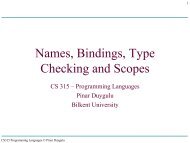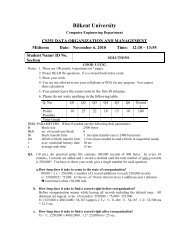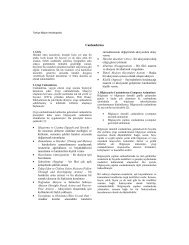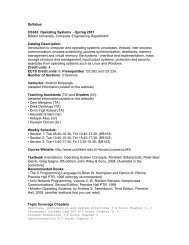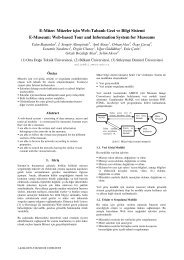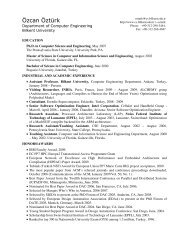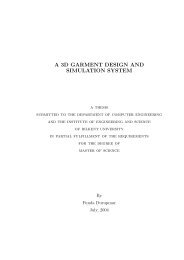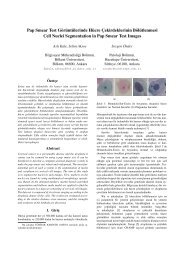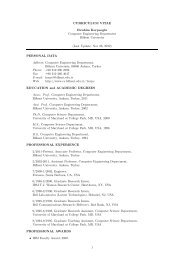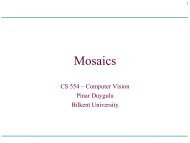On Probability of Success in Linear and ... - Bilkent University
On Probability of Success in Linear and ... - Bilkent University
On Probability of Success in Linear and ... - Bilkent University
Create successful ePaper yourself
Turn your PDF publications into a flip-book with our unique Google optimized e-Paper software.
key gets the correct value ranked among the top r out <strong>of</strong> 2 m possible c<strong>and</strong>idates,<br />
we say the attack obta<strong>in</strong>ed an (m − lg r)-bit advantage over exhaustive search.<br />
The traditional, more strict def<strong>in</strong>ition <strong>of</strong> success, where the attack discovers the<br />
right key as the first c<strong>and</strong>idate, corresponds to obta<strong>in</strong><strong>in</strong>g an m-bit advantage<br />
over an m-bit key.<br />
The analysis presented provides formulas for direct calculation <strong>of</strong> the success<br />
probability <strong>of</strong> l<strong>in</strong>ear <strong>and</strong> differential attacks. The amount <strong>of</strong> data required<br />
for an attack to achieve a certa<strong>in</strong> success probability can also be calculated<br />
through these formulas. Furthermore, the analysis shows that the aimed advantage<br />
level—that is, <strong>in</strong> more traditional terms, the number <strong>of</strong> key bits attacked—is<br />
one <strong>of</strong> the factors that affect the success probability <strong>in</strong> differential cryptanalysis<br />
directly besides the already established factors <strong>of</strong> the signal-to-noise ratio <strong>and</strong><br />
the expected number <strong>of</strong> right pairs.<br />
The notations <strong>in</strong> the paper common to all sections <strong>in</strong>clude φ <strong>and</strong> Φ for the<br />
probability density <strong>and</strong> the cumulative distribution functions <strong>of</strong> the st<strong>and</strong>ard<br />
normal distribution. Besides, B, N , <strong>and</strong> P are used for denot<strong>in</strong>g the b<strong>in</strong>omial,<br />
normal, <strong>and</strong> Poisson distributions, respectively.<br />
2 <strong>Success</strong> <strong>Probability</strong> <strong>in</strong> L<strong>in</strong>ear Cryptanalysis<br />
L<strong>in</strong>ear cryptanalysis, developed by Matsui[11], is a known-pla<strong>in</strong>text attack that<br />
exploits the statistical correlation among the pla<strong>in</strong>text, ciphertext, <strong>and</strong> key bits<br />
<strong>of</strong> a block cipher to discover the encryption key. The first step <strong>in</strong> a l<strong>in</strong>ear attack is<br />
to f<strong>in</strong>d a l<strong>in</strong>ear approximation for the cipher. A l<strong>in</strong>ear approximation is a b<strong>in</strong>ary<br />
equation <strong>of</strong> the bits <strong>of</strong> the pla<strong>in</strong>text, ciphertext, <strong>and</strong> the key, which holds with<br />
a probability p �= 1/2. The quantity |p − 1/2|, known as the bias, is a measure<br />
<strong>of</strong> correlation among the pla<strong>in</strong>text, ciphertext, <strong>and</strong> key bits, <strong>and</strong> it can be used<br />
to dist<strong>in</strong>guish the actual key from r<strong>and</strong>om key values. In an attack, the attacker<br />
collects a large number <strong>of</strong> pla<strong>in</strong>text-ciphertext blocks, <strong>and</strong> for each possible key<br />
value he counts the number <strong>of</strong> pla<strong>in</strong>text-ciphertext blocks that satisfy the approximation.<br />
Assum<strong>in</strong>g that the bias <strong>of</strong> the approximation with the right key<br />
will be significantly higher than the bias with a r<strong>and</strong>om key, the key value that<br />
maximizes the bias over the given pla<strong>in</strong>text sample is taken as the right key.<br />
In general, it may be sufficient to have the right key ranked reasonably high<br />
among the c<strong>and</strong>idates rather than hav<strong>in</strong>g it as the absolute highest. For example,<br />
<strong>in</strong> Matsui’s attack on DES, a 26-bit portion <strong>of</strong> the key was attacked where the<br />
right key was ranked among the top 2 13 . In this k<strong>in</strong>d <strong>of</strong> rank<strong>in</strong>g attacks, all<br />
c<strong>and</strong>idates ranked higher than the right key must be tried before the right key<br />
can be reached. Each c<strong>and</strong>idate must be checked with all comb<strong>in</strong>ations <strong>of</strong> the<br />
rema<strong>in</strong><strong>in</strong>g, unattacked bits to see if it is the right value. In such an attack,<br />
where an m-bit key is attacked <strong>and</strong> the right key is ranked rth among all 2 m<br />
c<strong>and</strong>idates, the attack provides a complexity reduction by a factor <strong>of</strong> 2<br />
m−lg r<br />
over the exhaustive search. In our analysis, we refer to m − lg r as the advantage<br />
provided by the attack.<br />
2




